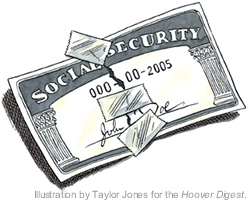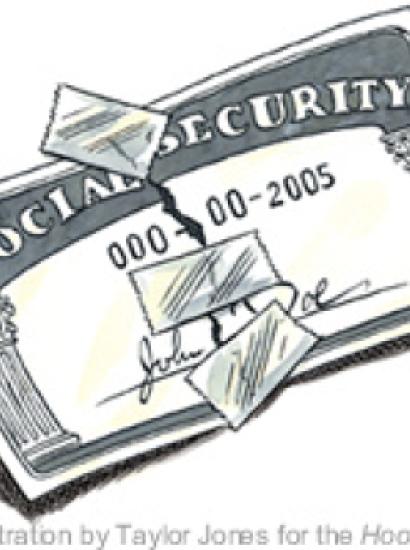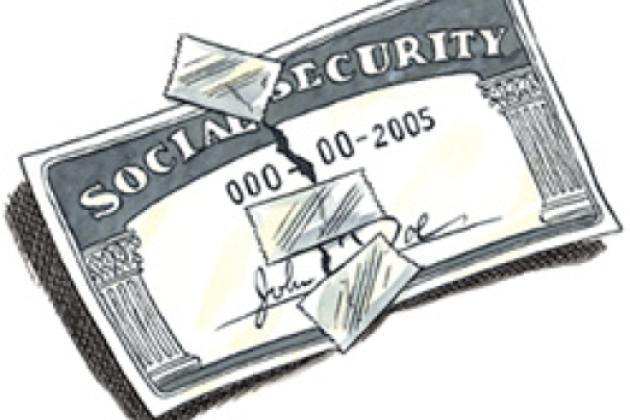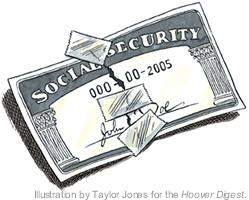- Budget & Spending
- Economics

There are three good reasons to establish private accounts for retirement benefits. First, private accounts are more consistent than the government program with fundamental economic principles, namely, the virtue of consumer sovereignty without significant distortions. Second, private accounts enhance, rather than reduce, the likelihood that contributors will receive what they expect. Benefits are more, not less, secure with private accounts. Third, private accounts reduce government moral hazard and do not sacrifice any of the benefits associated with a government-run Social Security program. Moving pension funds to the private sector removes another source of revenue that government officials have not been able to resist spending.
Much of the rhetoric has been misguided, with some proponents arguing that recipients will earn higher returns from private accounts (likely true). Opponents counter that the higher returns come at the cost of greater risk (also likely true). Further, opponents argue that the current system is not too much worse than the market alternative and that transaction costs will eat up much of the additions (questionable). But the real issues are: What does the current system do? What should be the goals of the system? Would private accounts achieve the desired goal more efficiently? The answer is that the current system performs some desirable functions but creates undesirable consequences. Private accounts accomplish the desired goals but eliminate most of the undesired consequences.
The current system does three things. First, it forces saving. Some individuals might be inclined to save less than the amount that is now set aside through payroll taxes.
Second, the current system provides insurance in a number of ways. One way is that individuals who work the minimum number of quarters for eligibility are entitled to the same benefits as those who work many more quarters. Another is that someone who becomes ill during middle age receives the same benefits as someone who is able to work until 65, provided they have the same income for calculating benefits. The system thereby pools risk across individuals. Insurance is also provided by making the benefits received independent of variations in returns to securities in which an individual might otherwise invest.
Third, Social Security redistributes income. The structure of floors and ceilings on benefits and contributions results in redistribution from some individuals to others. For example, males with family histories of heart problems redistribute income to healthy females because of differences in life expectancies that are not taken into account when benefit flows are determined. Ceilings on contributions for high earners redistribute toward wealthy young earners, but caps and minimum benefit levels redistribute income from those with high lifetime incomes to those with low lifetime incomes.
The Goals of the Social Security System
What should the system do? The legitimate goal of Social Security is to ensure that everyone has sufficient income to support some basic standard of living throughout retirement. Forced saving is at the heart of the system. Were individuals not forced to save, some would engage in moral hazard, overconsuming when young and allowing themselves to be destitute when old, knowing that they could then count on relatives, churches, or communities to care for them. Others would be less strategic but, lacking foresight, might end up in the same situation. Implicit in the notion that there should be some basic level of income is a desire to provide insurance by putting a floor on the amount of benefits. The Social Security system was not designed to tackle the major issue of optimal income distribution.
Who Is Affected?
How do private accounts address the goals of the Social Security system? Private accounts deal effectively with the desire to force people to save but do so in a superior way, by allowing individuals to make their portfolio decisions. This is important only for those who, if left on their own, would not choose to save enough in the form of an asset with the same payoff properties as Social Security. For individuals who would optimally save significantly more in the Social Security–like asset than the amount forced through the payroll tax, choice is not an issue. An individual who, in the absence of government programs, would save $5,000 per year, investing $2,000 in a diversified stock portfolio and $3,000 in the Social Security–like asset is unaffected by a $2,500 payroll tax that pays out in accordance with returns on government bonds. He simply reduces his private investment in that asset to $500, maintains the investment in stocks at the $2,500 level, and allows the government to provide $2,500 worth of Social Security. The difference comes for individuals who would not voluntarily choose to invest more than the mandated amount in the Social Security–like asset. These individuals are forced to distort their investment decisions and to accept the risk-return profile that the government chooses for them. Given the large fraction of individuals who have very few assets other than Social Security and some home equity as they enter retirement, the constraint is binding for a large part of the population.
Social Security Benefit Risk
An important detail affects the story, even when the constraint appears slack. First, what goes in does not come out. Individuals who buy treasuries privately can be virtually assured that the return they receive is that which was promised. But there is no guarantee in a pay-as-you-go system that the benefits, even on average, will reflect the market rate of interest on treasuries. Benefits and contributions are politically determined, and there is no guarantee that any particular return will be realized. So the Social Security–like asset is not the equivalent of a government bond. The risk with Social Security is that Congress could change the structure of the benefits. That risk is absent when individuals invest privately in U.S. treasuries. The face value of those bonds guarantees a return to all who invest in them, and default is outside the realm of reasonable possibility.
What Should Social Security Do—and Do Private Accounts Do It?
A case can be made for forced saving, perhaps even with an insurance component, but there is little reason to believe that the subtle redistributive properties implicit in the current system are desirable. Some redistribution inherent in the system is perverse from an equity point of view (caps on the amount contributed). Social Security redistributions are also not well integrated with other government tax and subsidy programs, such as the federal income tax.
Private accounts provide for the forced saving that is desired but additionally allow consumer sovereignty, especially for the majority of individuals who would not choose to save as much in the Social Security–like asset as the government currently requires. Most economists have a deep appreciation for individual choice as long as there are no obvious externalities.
But there is also some need for insurance because individuals who do not have the vision to provide for themselves in old age cannot be expected to hedge future income risks appropriately. As a result, the government might be forced to bail out those who make bad investments or to bail out a large segment of society if even safe investments yield very low returns.
There are at least two solutions to this problem. The first—the one currently being discussed—is to provide a base level of benefits from government-run pension programs, namely, Social Security. As long as that is sufficient to provide some base-level standard of living, nothing else may be required.
An alternative is to insure the private accounts, whereby the government guarantees a minimum return or minimum annuity. To do this, it would be necessary to regulate the kinds of investments that can be part of the private accounts, lest we see a repeat of the S&L crisis, as individuals take on high-risk, high-return investments knowing that the government will bail them out.
Two Key Advantages to Private Accounts
Other than consumer sovereignty, what are the advantages of private accounts? Private accounts provide more security for recipients and eliminate government moral hazard.
Investments made privately provide a stronger lockbox than any offered by the government. Whether reality or political expediency, talk of a funding crisis can lead to changes in benefits, age of eligibility, or other rules that affect the rate of return to the investment. The private markets are more secure. Suppose that the government “promises” an average return to the payroll tax that individuals have paid throughout their lifetimes. Pressure on the government to reduce spending or eliminate deficits could at any point in time induce legislators to reduce benefits, change the age of eligibility, or make any of a variety of decisions that would reduce the actual return received by those who had paid their payroll taxes throughout their lifetimes.
Suppose instead that individuals had been permitted to reduce their payroll tax and invest the funds in some approved asset, such as U.S. treasuries. The nominal value of those bonds will be paid with virtual certainty. So the risk associated with private investment in government treasuries is lower than that associated with a payroll tax that is then used to finance Social Security at the same promised rate of return.
A second advantage is the reduction in government moral hazard that comes from moving funds from the government to the private sector. John Cogan has shown that, for every dollar of unanticipated increase in government funds through the payroll tax, there is a corresponding increase of one dollar in government expenditures. When the economy is good and payroll taxes rise as a consequence of increased employment and rising incomes, the government collects more money. At the same time, it spends it.
Similar work by Gary Becker and Kevin M. Murphy finds that state governments do the same thing. Increases in state revenues associated with changes in the economy are met by increases in state expenditures.
Moving money from the payroll tax to the private sector will allocate resources more in line with market principles. Some increased expenditure by the government that follows unanticipated increases in revenues may be worthwhile, but most economists believe that the market does a better job than politicians of allocating resources in an efficient manner.
Paying for the Transition
The next generation, however, receives a benefit. Because one-third of the payroll tax has gone into private saving, now only two-thirds of the total benefits received by pensioners must be paid through government funds. So the next generation would pay less than the current one to support the retirement of their parents.
To make things neutral, the current working generation could pass the one-third obligation to support current retirees that is no longer paid through the payroll tax to the next generation. Deficit spending that is paid for by floating treasuries would leave things unchanged to a first approximation. The alternative of taxing the current working population to pay the bill would put tax policy at odds with itself because the point is to lower government intermediation, and raising taxes, say through the income tax, to pay the bill would just offset the reduction in the payroll tax. Deficit spending is consistent with the original notion of pay-as-you-go, leaving the situation of the previous, current, and future generations unchanged.
The Virtues of Private Accounts
Private accounts accomplish the forced saving that is desired to avoid problems passed to taxpayers that result when individuals do not save for themselves. But private accounts are superior to the current system in that they avoid strange patterns of redistribution, eliminate government moral hazard that takes the form of spending surplus funds, and make recipients’ benefits more secure. Additionally, they do so without changing obligations faced by current and future generations.
















